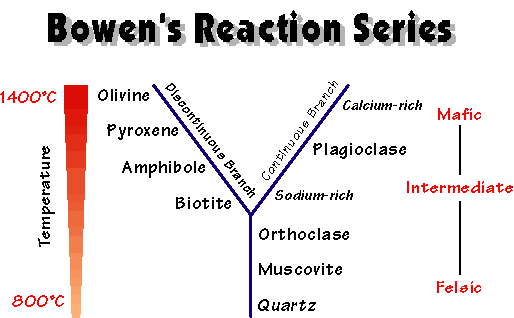What is Meant by Continuous Reaction Series
Bowen's Reaction Series
In the early 1900's, N. L. Bowen and others at the Geophysical Laboratories in Washington D.C. began experimental studies into the order of
crystallization of the common silicate minerals from a magma. The idealized progression which they determined is still accepted as the general model for
the evolution of magmas during the cooling process.
The Principles that Bowen realized are as follows:
A) As a melt cools minerals crystallize that are in thermodynamic equilibrium with the melt (dissolution equals crystallization; if no equilibrium either crystallization will dominate [supersaturation], or dissolution [undersaturated]).
B) As the melt keeps cooling and minerals keep crystallizing, the melt will change its composition.
C) The earlier formed crystals will not be in equilibrium with this melt any more and will be dissolved again to form new minerals. In other words: these crystals react with the melt to form new crystals, therefore the name reaction series.
D) The common minerals of igneous rocks can be arranged into two series, a continuous reaction series of the feldspars, and a discontinuous reaction series of the ferromagnesian minerals (olivine, pyroxene, hornblende, biotite)
E) This reaction series implies that from a single "parental magma" all the various kinds of igneous rocks can be derived by Magmatic Differentiation (see below)
To summarize: Bowen determined that specific minerals form at specific temperatures as a magma cools. At the higher temperatures associated with mafic and intermediate magmas, the general progression can be separated into two branches (see below). The continuous branch describes the evolution of the plagioclase feldspars as they evolve from being calcium-rich to more sodium rich. The discontinuous branch describes the formation of the mafic minerals olivine, pyroxene, amphibole, and biotite mica. The remarkable thing that Bowen found concerned the discontinuous branch. At a certain temperature a magma might produce olivine, but if that same magma was allowed to cool further, the olivine would "react" with the residual magma, and change to the next mineral on the series (in this case pyroxene). Continue cooling and the pyroxene would convert to amphibole, and then to biotite. The reason for this "stepped" evolution of minerals is that with dropping temperature we we have decreasing thermal vibration of molecules, and that allows silica to form more complex structures. Thus, olivine with its isolated silica tetrahedrons forms at the highest temperatures, and as temperatures drop silica tetrahedrons first manage to join together in chains (pyroxenes), then in ribbons (amphiboles), and then sheets (micas). Finally, at the lowest temperatures the two branches merge and we get the minerals that are common to felsic rocks - muscovite mica, orthoclase feldspar,and quartz (3D frameworks).

Magmatic Differentiation: With this term we describe the process of separating the magma into several batches (separating crystals from melt) as it evolves and migrates upwards in the earth's crust. E.g. we might early on separate olivine and pyroxene (crystal mush), and would thus create a peridotite (more mafic than basalt). The remaining melt would crystallize pyroxene, hornblende, and plagioclase with intermediate Ca content (andesine), and might erupt from a volcano and form andesite. Or, if the material remained buried, the crystal fraction would form a diorite from which in turn a granitic melt would rise. The parental magma that Bowen envisioned was a "primitive" basalt with high Fe and Mg contents and fairly low SiO2 contents.
This gradual change in mineral composition during differentiation is accompanied by a change in color (mafic rocks dark, felsic rocks light) and density of the respective rocks, and is the basis for most of the accepted classification schemes of igneous rocks.
The original composition of the magma of course determines the variety of igneous rocks we can derive from it. An originally dioritic/andesitic magma for example could never give rise to a basalt, but may give rise to a granite. A magma may be modified by mixing with another magma that is further or less far evolved, and then rocks of unusual mineral composition may form. Another way in which a magma can be modified is by assimilation of wall rock during its rise through the crust.
Source: https://geol105.sitehost.iu.edu/images/gaia_chapter_5/bowen.htm

0 Response to "What is Meant by Continuous Reaction Series"
Post a Comment